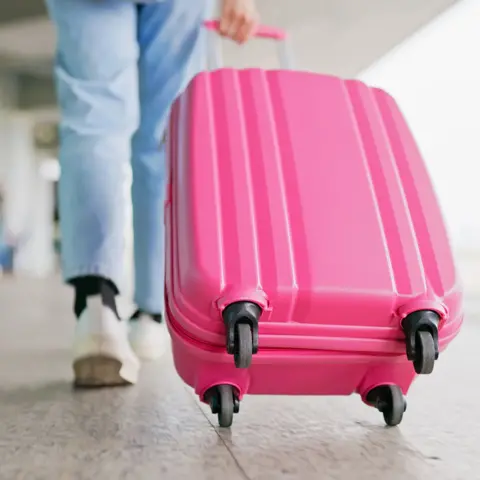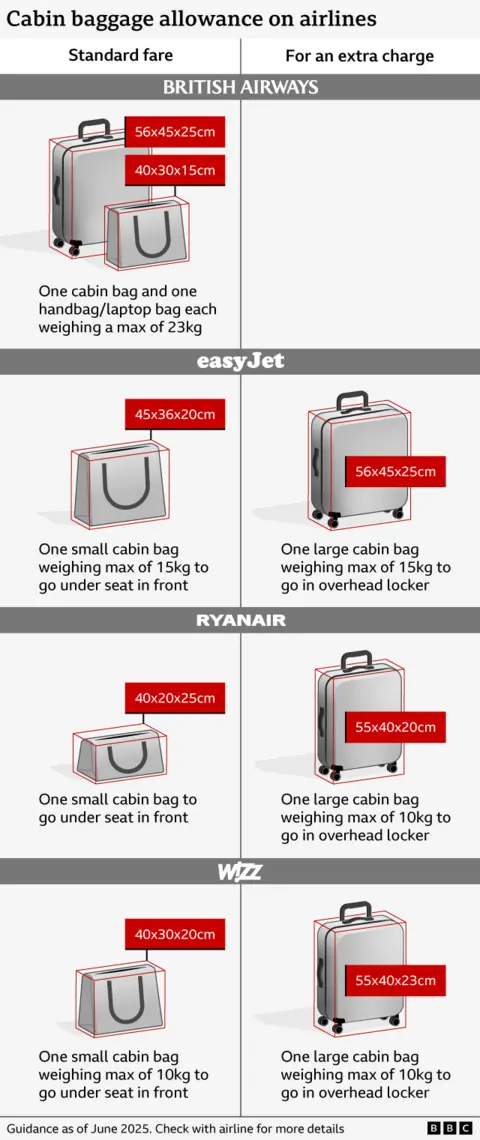BBC News
 Getty Images
Getty ImagesDetermined to avoid baggage fees for his holiday to Pisa, Benjamin Till trawled several different shops armed with a tape measure in search of the right suitcase.
Eventually, he found a case within the dimensions EasyJet allows for a free underseat bag – or so he thought.
When Mr Till arrived at London Gatwick Airport in December 2023, he discovered those measurements included wheels, meaning his bag was deemed slightly too big.
He protested, but eventually paid £48 to bring the bag on board. He says he was told to remove the wheels for the way back – which he did.
But at the gate on his way home, he was told the suitcase was still too large, so he sat on the floor, unpacking his dirty underwear and souvenirs into a bin bag.
“I don’t mind admitting that I actually burst into tears because it was so humiliating,” he says.
An EasyJet spokesperson told the BBC its ground crew had to ensure non-checked bags were within maximum dimensions “to safely and securely fit”, and that rules were made clear to customers when they booked.
 Benjamin Till
Benjamin TillStories of passengers caught out by baggage rules they feel are inconsistent or confusing are common, with many customers complaining or seeking clarity from budget airlines on social media.
Different airlines have varying rules on the acceptable size and weight of an underseat personal item or an overhead cabin bag, with some charging customers to bring the latter.
For people who fall foul of these rules, some airlines charge hefty fees to upgrade a bag from a free personal item to an overhead cabin bag at the airport gate, or to stow an oversized cabin bag in the hold.
Passenger confusion has prompted the European Union’s largest consumer group to push for fairer and more consistent hand luggage rules, and caused one government to start cracking down on airlines over bag charges.
The EU is now looking at changing its laws – changes which would also affect UK passengers who are travelling to or from an EU destination using an EU-based airline.
On Thursday, EU transport ministers proposed standardised sizing for free underseat baggage on EU airlines, among other air travel and passenger rights’ changes – meaning this could become EU law if their position is accepted by the European Parliament.
Budget airlines say their baggage policies comply with the law while keeping fares low, but they have been facing mounting pressure and calls for change.
What could change, or not, for hand baggage?
EU transport ministers proposed that passengers should be guaranteed one free personal item, measuring up to 40x30x15cm (including wheels and handles) – or which could reasonably fit under a plane seat.
These rules would apply to EU-based airlines (such as Ryanair, Wizz Air and EasyJet), including when they are carrying passengers from a non-EU country like the UK to an EU country and vice-versa, but not third-party airlines.
New rules would add clarity to an EU court ruling from 11 years ago, which stated hand baggage should not be subject to an extra fee, provided it met “reasonable” weight and dimensions, but did not say what reasonable was.
Currently, Ryanair allows a free carry-on bag of 40x20x25cm, while EasyJet’s dimensions for a free bag are a more generous 45x36x20 cm, including wheels and handles.
The ministers’ proposal was silent, however, on the issue of whether airlines could charge for overhead cabin bags – meaning that if their proposal was adopted into law, the current situation would not change and airlines could keep charging for that kind of hand baggage, which some in Europe have lobbied to stop.
The European Consumer Organisation, BEUC, an umbrella group for 45 independent consumer organisations from 32 countries, believes Thursday’s proposals do not go far enough, and legitimise “charging for reasonably sized hand luggage”.
In November, five airlines were fined a total of €179m (£150m) in Spain for “abusive” practices, including charging for hand luggage. Spain’s Consumer Rights Ministry said at the time that it planned to ban charging extra for carry-on luggage and other policies.
The airlines had said they would appeal the decision.

Regarding charges for overheard cabin bags, Ryanair said it fully complied with EU law in its policy, which allows one small bag on board free of charge.
“If airlines were forced to include additional carry-on bags as part of the basic fare, it would reduce choice and drive up air fares for all passengers, which would harm consumers,” the airline said.
Industry group Airlines For Europe said charging different amounts depending on baggage “allows passengers to choose the exact services that best suits their needs”.
What do customers want?
Hand luggage dimensions should be universal, says Jane Hawkes, a consumer expert specialising in travel.
“I don’t really see why it can’t be, and why they can’t come to a voluntary agreement as to what those requirements should be for your baggage,” she tells the BBC.
“There have to be restrictions, obviously, but a one-size-fits-all kind of approach would make it a lot simpler for passengers,” she says.
BEUC said policymakers should define what “reasonable” size and weight was “to avoid surprises at the airport and ultimately reduce the number of disputes costing consumers and airlines time and money”.
Ms Hawkes suggests passengers make sure they measure their bag after it is packed, as it may expand when it is full and go over the limit.
She adds that consumers should not just be swayed by the fare price, as “if you’ve got an airline that encompasses [baggage] without you having to pay extra costs to start with, then that might be more of a better option for you”.
Mr Till would welcome a one-size-fits-all approach to underseat bags.
“It’s just really, really unfair and ridiculous and there should be one size that goes across all of the airlines,” he says.
He also criticises the permitted size of underseat cabin bags, saying “it was such a tiny, tiny size of luggage that you were allowed that it had taken me so long to find something that was so small”.
Still, he was grateful for the inexpensive air fare, and the place he had to stay in Italy, because “otherwise I wouldn’t be able to come to this beautiful country”.


